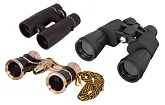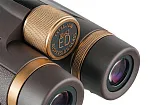Basic information about types of binoculars
Binoculars and spotting scopes can be classified in many different ways. Spotting scopes and monoculars have only one eyepiece to look through. Binoculars have two eyepieces, so that you can observe using both your eyes. In general, binoculars and spotting scopes designed for different purposes vary widely in design and specifications.
General purpose binoculars have a universal design and can be applied for many different purposes; they perform very well when observing wildlife or watching sports games. They might not be full of modern “fancy” features, but these binoculars perform exceptionally well whatever task you find yourself doing. General purpose binoculars also make a good starting point for you – after using them you will understand what capabilities you need from your next, more serious tool.
Compact binoculars have small dimensions and a light weight. They fit easily into pocket, purse or glove compartment. The main advantage of these binoculars is their compact size, but, as you would expect, they also have small objective lens, magnification power, and exit pupil diameter. They perform quite well in the bright light of day, but do not count on them in low light conditions. They are a good choice for children and as a backup tool.
Digital camera binoculars
These binoculars are equipped with an integrated digital camera. They can shoot objects you are interested in. Usually these binoculars are more bulky, heavy and expensive. Additional accessories and features may include wide-angle eyepieces, a backlight for night shooting, and video recording.
These binoculars have large objective lenses, which make them very useful for observations in low light conditions. Large binoculars also have a much wider field of view. For example, you will be able to see the whole track in a racetrack. That’s why these binoculars are heavy and expensive, and aren’t very suitable for hikes and walks.
Image stabilizing binoculars
Image stabilized binoculars are designed to minimize image shaking. The perceived image will be sharp and clear. Such binoculars are great for observations on the go, from your moving car or boat. But, of course, image stabilizing binoculars are more expensive than regular ones.
Marine binoculars have a waterproof shell their body has an ergonomic design. Some can stay afloat if you accidently drop them in the water. Typically, marine binoculars are very reliable and sturdy, have large objective lenses which allow you to observe in dim light conditions; for example, at dusk or in fog. Such binoculars usually are lightweight; they can be equipped with an image stabilization system. Levenhuk binoculars for marine use are the classic example of high-quality marine equipment.
These reliable binoculars have very sturdy shells in order to withstand mechanical shock and dropping. Often these binoculars have efficient protection against moisture, as well as high-quality optics, and significant weight. Military binoculars can be equipped with built-in compasses and night vision devices.
Monoculars are usually pocket sized, and they have small magnification power. Although their standard magnification is about 2-5 times, they can be successfully used in lecture halls and presentations. Monoculars are not expensive; you can instantly pull them out of your pocket when you need them. By the way, you can always keep a compact monocular in your backpack as a backup tool and use it when your full-sized instrument in not available for some reason.
There are several methods of low-light imaging. Some night vision binoculars and spotting scopes simply increase the amount of collected light. Others collect, amplify and convert infrared light (thermal radiation) into visible light. These binoculars are often used for observing nocturnal animals, as well as for military purposes.
Rangefinder
Rangefinders send out laser light and, when the signal is reflected back, the instruments measure the traveling time in order to determine the distance. Some have a scan mode to search for achievable goals during shooting practice, golf or hunting. Such instruments tend to be expensive.
A spotting scope looks like a small telescope; you can hold it in your hands. Typically spotting scopes are used for terrestrial observations (not for astronomy). They have higher magnification power than binoculars, but maintain lightweight. Spotting scopes were originally designed for shooting practice, and they are still widely used for this purpose.
Binocular telescope
The binocular telescope is a combination of binoculars and a telescope. Binocular telescopes often provide the same objective lens diameter and magnification as usual telescopes, but are equipped with two eyepieces so that you can use both eyes for observations. Some people prefer to use both eyes during observations to get more realistic volume (stereo) images. Often, these binoculars require special mounting on a tripod, because they are quite heavy, but, at the same time, binocular telescopes are more convenient and affordable than regular telescopes. The important feature of such telescopes is their convenient removable eyecups (often made of soft rubber).
Waterproof binoculars are perfect for hiking, observing wildlife, and hunting; they can be used near a lake, sea, or river. Their completely waterproof shell protects the optics, prevents moisture from entering the interior of the instrument, and eliminates fogging. Be cautious, sometime sellers describe their products as “all-weather” and “water repellent,” but that doesn't necessarily mean that they are completely protected against moisture. Some waterproof binoculars can stay afloat if you accidently drop them in the water – such binoculars are much harder to lose. They are worth buying, if you have to travel by water or deal with fog or high humidity, and will pay for themselves. You can find waterproof binocular models in this catalog section.
Binoculars with variable magnification, Zoom binoculars
Zoom binoculars allow you to increase (zoom in) and decrease (zoom out) magnification power in order to get a closer look at the desired object or to get a wider field of view. For example, if the inscription on the binoculars’ body says 8-25x30, that means magnification is variable from 8x to 25x. You can use such binoculars for bird watching – use small increase to explore terrain, and when you find a bird increase magnification power to get a more detailed view. However, this technology has not yet reached perfection; that’s why not everyone likes them.
Any reproduction of the material for public publication in any information medium and in any format is prohibited. You can refer to this article with active link to eu.levenhuk.com.
The manufacturer reserves the right to make changes to the pricing, product range and specifications or discontinue products without prior notice.



